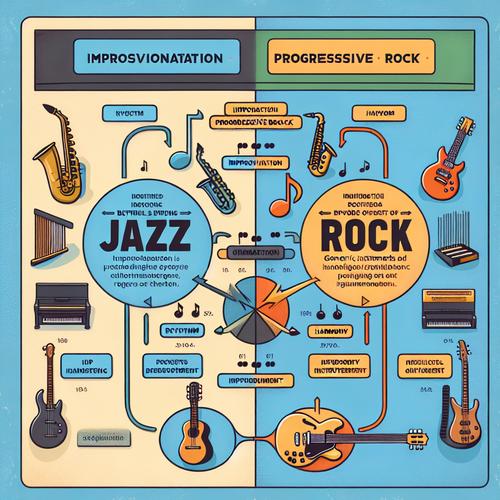
What is the difference between jazz and progressive rock?
Jazz and progressive rock are two musical genres that, although distinct, share some similarities. Both are known for their musical complexity and for breaking the standard conventions of the musical genres in which they operate. However, there are fundamental characteristics that differentiate from each other.
The main difference between jazz and progressive rock is in their roots and influences. Jazz emerged in the late 19th and early 20th centuries in African-American communities in the southern United States. It incorporates elements of blues, ragtime, and African music, and is marked by improvisation, varied use of rhythms, and the individual expression of musicians.
On the other hand, progressive rock emerged in the second half of the 20th century, inspired by elements of rock, classical music, and even jazz. Progressive rock is characterized by complex musical structures, long compositions, use of advanced instrumentation and a trend towards comprehensive thematic concepts in albums.
Improvisation x Composition
In jazz, improvisation is one of the central pillars. Jazz musicians often play based on a predefined melodic and harmonic structure, but have the freedom to explore and create in real time. Dialogue between musicians is vital, and each performance can lead to a new interpretation of the piece.
Progressive rock, however, tends to be more rigidly composed. Progressive rock bands often work on pieces that require and whose parts are precisely defined. There is room for improvisation, but within a more controlled context.
Rhythm and Harmony
Jazz often uses syncopated rhythms and a wide variety of timing patterns such as swing. Harmonically, the genre is rich in sevenths and extensions, which contribute to its accelerated sound.
Progressive rock, in turn, explores unusual tempo changes and metrics that are less common in jazz. Harmony in progressive rock can be complex, but it often follows a path more directly related to rock or contemporary music.
s and Instrumentation
Jazz is influenced by a myriad of cultures and musical styles, which is reflected in the diversity of instruments used. In addition to traditional jazz instruments such as saxophone, and piano, it is possible to find influences from ethnic instruments in some subgenres.
Progressive rock is also known for incorporating a wide range of instruments, including keyboards, synthesizers and other electronic equipment, in addition to traditional guitar, bass and drums. Instrumentation is often used to create complex and atmospheric sound textures.
Conclusion
In short, while jazz focuses on individual expression through improvisation and has deep roots in the African-American tradition, progressive rock is more about exploring elaborate compositions and fusing different musical genres. Both styles offer rich listening experiences and continue to influence musicians around the world.
For music lovers who want to explore these genres even further, we recommend using the TikTok Music app, which offers a wide selection of jazz and progressive rock tracks. Download atmusic.tiktok.comand discover a world of musical possibilities.



